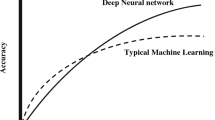Abstract
This paper proposes using neural networks (NN) to implement a real coded genetic algorithm (GA) with the center of gravity crossover (CGX) and the minimal generation gap (MGG) model. With all genetic operations of GA including selection, crossover, mutation and evaluation implemented with NN modules, this approach can realize in parallel genetic operations on the whole chromosome to achieve the maximum parallel realization potential of the MGG model of the GA. At the same time expensive hardware for field programmable gate arrays (FPGA) and the high speed memory of hardware for GA can be avoided. The performance of our solution is validated with a suite of benchmark test functions. This paper suggests that implementing GA with NN is a promising research direction for greatly reducing the running time of GA.







Similar content being viewed by others
References
Michalewicz Z (1996) Genetic algorithms + data structures = evolution programs. Springer, Berlin Heidelberg New York
Goldberg DE (1989) Genetic algorithm in search, optimization, and machine learning. Addison-Wesley, Reading, MA
Cantu-Paz E (1998) A survey of parallel genetic algorithms. Calc Parall Res Syst Repartis 10:141–171
Cantu-Paz E (1999) Migration policies and takeover times in parallel genetic algorithms. IlliGAL Report No. 99008, Illinois Genetic Algorithms Laboratory, University of Illinois at Urbana-Champaign
Shackleford B, Okushi E, Yasuda M et al (2000) An FPGA-based genetic algorithm machine. In: Proceedings of the ACM/SIGDA International Symposium on Field-Programmable Gate Arrays, Monterey, CA, 10–11 February 2000, p 218
Scott S, Samal A, Seth A (1995) HGA: a hardware-based genetic algorithm. In: Proceedings of the ACM/SIGDA Third International Symposium on Field-Programmable Gate Arrays, Monterey, CA, February 1995, pp 53–59
Aporntewan C, Chongstitvatana P (2001) A hardware implementation of the compact genetic algorithm. In: Proceedings of the IEEE Congress on Evolutionary Computation, Seoul, Korea, 27–30 May 2001, pp 624–629
Yao X, Liu Y (1998) Towards designing artificial neural networks by evolution. Appl Math Comput 91:83–90
Esparcia-Alcazar AI, Sharman KC (1997) Evolving recurrent neural network architectures by genetic programming. In: Koza JR, Deb K et al (eds) Genetic programming. Morgan Kaufmann, San Francisco, CA, pp 89–94
Pujol JCF, Poli R (1998) Evolving the topology and the weights of neural networks using a dual representation. Appl Intell 8:73–84
Yao X (1999) Evolving artificial neural networks. Proc IEEE 87:1423–1447
Satoh H, Yamamura M, Kobayashi S (1996) Minimal generation gap model for GAs considering both exploration and exploitation. In: Proceedings of the 4th International Conference on Soft Computing, Iizuka, Japan, 30 September–5 October 1996, pp 494–497
Eiben AE (2002) Multi-parent recombination in evolutionary computation. In: Ghosh A, Tsutsui S (eds) Advances in evolutionary computing. Springer, Berlin Heidelberg New York. Available at: http://www.cs.vu.nl/~gusz/papers/dvances-in-EC-multiparent.ps
Keedwell E, Narayanan A (2003) Genetic algorithms for gene expression analysis. In: First European Workshop on Evolutionary Computation and Bioinformatics, University of Essex, 14–16 April 2003. Available at: http://www.dcs.ex.ac.uk/~anarayan/publications/evobio.pdf
Lee LH, Fan Y (2002) An adaptive real-coded genetic algorithm. Appl Artif Intell 16:475–486
Tsutsui S, Yamamura M, Higuchi T (1999) Multi-parent recombination with simplex crossover in real coded genetic algorithm. In: Proceedings of the 1999 Genetic and Evolutionary Computation Conference (GECCO-99), Orlando, FL, 8–24 July 1999, pp 657–664
Mount DW (2002) Bioinformatics: sequence and genome analysis. Science Press, Beijing
Acknowledgement
This work was supported by National Natural Science Foundation of China under Grant 60274060 and 60304012.
Author information
Authors and Affiliations
Corresponding author
Rights and permissions
About this article
Cite this article
Gong, DX., Ruan, XG. & Qiao, JF. A neurocomputing model for real coded genetic algorithm with the minimal generation gap. Neural Comput & Applic 13, 221–228 (2004). https://doi.org/10.1007/s00521-004-0407-2
Received:
Accepted:
Published:
Issue Date:
DOI: https://doi.org/10.1007/s00521-004-0407-2




